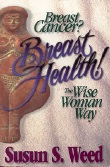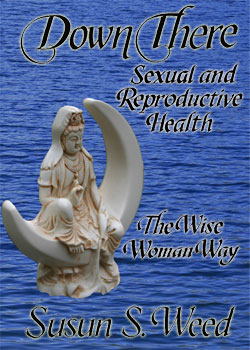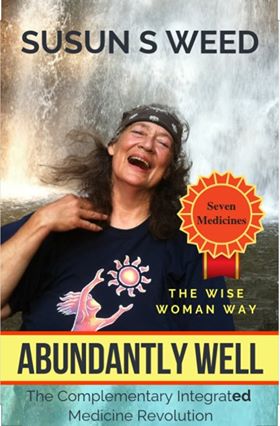
INDEX | HEALING WISE | Q & A with SUSUN | GREEN BLESSINGS
THE LIBRARY | PEOPLE MAKING CHANGE | GODDESS ART GALLERY
Healing Wise ...
with Susun Weed
The Medicine Wheel of Plant Uses, part 2
The taste of the East, place of newness, is sweet and bland. Mother's milk is sweet and bland. The cereal crops (wheat, rice, corn) are sweet and bland. The East is Food, and it connects to the realm of the herbivores. The plants of the East give us NOURISHMENT.
Salty is the taste of the South, place of sweat and blood. Seaweed and miso are salty, just as amniotic fluid is salty. The South is Tonics, and it connects to the realm of the ocean. The plants of the South are a TURN ON.
In the West, place of death and the ancestors, the taste is intensely bitter, horribly bitter, inedibly bitter -- a bitter that increases even after you spit it out. Bitter as gall. Medicinal drugs are bitter. Poisons are bitter. The West connects to the realm of the mushrooms, those non-flowering plants that live on dead and decaying matter. The plants of the West can CHANGE YOUR MIND.
And in the North, place of deepness and clarity, the taste is aromatic. Here are the herbs you buy at the grocery store; most of them are in the mint family. These are the herbs your mother uses, the seasoning herbs, the ones loaded with aromatic oils. The realm of the oils connects to the North. And the plants of the North give us WISDOM.
We will look deeply at each of the directions, its taste, the Goddesses who guard it, the realms it opens, and the lessons each has to teach us.
The four moving questions:
The answers to these questions will change where a plant appears on the medicine wheel.
1. What part? The leaves and berries of Phytolacca americana (poke) can be eaten, the roots and seeds are used cautiously as medicines but are considered poisonous. The petioles of rhubarb are eaten, but the leaves and root are not. Burdock root is sweet, the leaves are incredibly bitter. One of my pet peeves: Herbals that tell me to use a particular plant but give no clue as to the part of the plant I should use.
2. When harvested? The amount and type of constituents in a plant differs at different times of the year. Perennial roots store winter food in the form of carbohydrates. Dig poke roots in the fall after the first frosts (cold weather concentrates the carbohydrates into the roots) and tincture it immediately in 100 proof vodka, and the alkaloids will be buffered by the sugars and starches (which precipitate out and must be shaken from the bottom up into the liquid before use). Roots dug in the spring will have a higher percentage of alkaloid, and may be more poisonous or more medicinal, depending on the plant. Even rhubarb changes as it grows (oxalates concentrate in it throughout the growing season), so it usually harvested only in the late spring, early summer.
3. How prepared? If you harvest the right part of the rhubarb in the right season, but serve it raw instead of cooked, it would be unpalatable. If you harvest poke leaves at the right time (early spring), you could still poison yourself, unless you cook them in three changes of water.
Different methods of preparation draw out different constituents from plants and move their position on the medicine wheel. If sugar cane is prepared by refining all the minerals out of it, it moves from the east to the west; it no longer nutritive, but now poisonous.
Water is the universal solvent, so many herbs are dried and used as teas or infusions. Minerals, vitamins, sugars, starches, hormones, tannins, volatile oils, and some alkaloids (caffeine, for instance) dissolve well in water, given sufficient time or high enough heat. Fresh herbs are the best sources of volatile oils and are best made into teas. Dried herbs are better sources of nutrients and medicinal properties and are best made into infusions.
Alcohol will dissolve and extract resins, oils, and alkaloids. It does not extract nutrients such as vitamins or minerals, but it does extract sugars, starches, and hormones.
Vinegar is the best menstruum for dissolving minerals out of plants. Apple cider vinegar -- pasteurized, please -- is my favorite choice.
Fats and oils extract the oily and resinous properties of an herb, many of which are strongly antibacterial, antifungal, antiseptic, and wound-healing.
Traditional Chinese Medicine has many methods of preparation, and even the manner in which the herb is cut for drying is considered critical to the medicine. In addition to the commonly available forms of herbs (teas, tinctures, ointments, capsules), they also roast herbs, smoke herbs, fry herbs, and cook them with honey.
4. How much to take? At last, a wonderful rhubarb pie! But better not eat more than one piece, or you'll be on the toilet all night. Plants of the East can generally be eaten in any quantity, even daily if necessary. Plants of the West need to be used in tiny amounts and rarely. Those from the South and North are used moderately, to correct and enliven the diet.
The closer to the west the plant lies, the more critical the question of dose becomes. The difference between one cup of coffee and two is not so great, but the difference between one cup of digitalis and two is. The difference between 10 and 20 drops of most herbal tinctures is inconsequential, but the difference between 10 and 20 milligrams of a drug may be the difference between life and death. The question of dose is one that is hotly contested among herbalists, and, of course, the answers to the first three questions change the potency of the preparation and thus the answer to the fourth question.
The difference between an herbal tea and an herbal infusion, or "standard brew" as Juliette de Bairacli Levy styles it, was for me, the difference between dabbling in herbs and using them effectively. So please pay attention here. This is important. To make an infusion: Place one ounce dried herb in a quart jar and fill it to the top with boiling water. Screw a tight lid onto it and allow it to sit, just like that, for at least 4 hours. (Can you hear the minerals dissolving, ever so slowly?) When your infusion is done, strain the plant material out, returning it to the earth, and drink the liquid, hot or cold or at room temperature. What you don't consume after straining is best kept in the refrigerator and drunk within 48 hours.
Good Enough to Live (Not Die) For Stir-Fry \ Serves 3-4

- 6-8 large cloves garlic, sliced thinly
- 1 tablespoon/15 ml olive oil
- 1 cup/250 ml fresh shiitake, sliced or 1 ounce/30 grams dried
- 2-4 fresh yellow dock roots
- 1-2 fresh burdock roots
- 1-2 fresh dandelion roots
- 1 pound/ 500 grams tofu cut in cubes
- 2 cups/500 ml cooked fresh stinging nettles
- 1/2 cup/125 mI almonds
- 1 tablespoon/15 ml tamari
Cook garlic briefly in oil at the lowest possible heat. Raise heat a little. Add mushrooms and cook for several minutes, stirring often. Slice roots thinly on the diagonal and add them to the skillet. Cook for five minutes, stirring frequently. Add tofu, nettle leaves, and some of the nettle cooking water. Cover tightly and cook at medium-high heat for five minutes. While it cooks, slice and toast almonds. To serve, pour over soba (buckwheat noodles) or brown rice, sprinkle with tamari, and garnish generously with almonds.

|
Susun Weed’s books: |

|
Wise Woman Herbal for the Childbearing Year
Author: Susun S. Weed.
Simple, safe remedies for pregnancy, childbirth, lactation, and newborns. Includes herbs for fertility and birth control. Foreword by Jeannine Parvati Baker. 196 pages, index, illustrations.
Retails for $14.95
Order at: www.wisewomanbookshop.com
|

|
Healing Wise
Author: Susun S. Weed.
Superb herbal in the feminine-intuitive mode. Complete instructions for using common plants for food, beauty, medicine, and longevity. Introduction by Jean Houston. 312 pages, index, illustrations.
Retails for $21.95
Order at: www.wisewomanbookshop.com |

|
NEW Menopausal Years the Wise Woman Way
Author: Susun S. Weed.
The best book on menopause is now better. Completely revised with 100 new pages. All the remedies women know and trust plus hundreds of new ones. New sections on thyroid health, fibromyalgia, hairy problems, male menopause, and herbs for women taking hormones. Recommended by Susan Love MD and Christiane Northrup MD. Introduction by Juliette de Bairacli Levy. 304 pages, index, illustrations.
Retails for $22.95
Order at: www.wisewomanbookshop.com
For excerpts visit: www.menopause-metamorphosis.com
|

|
Breast Cancer? Breast Health!
Author: Susun S. Weed.
Foods, exercises, and attitudes to keep your breasts healthy. Supportive complimentary medicines to ease side-effects of surgery, radiation, chemotherapy, or tamoxifen. Foreword by Christiane Northrup, M.D. 380 pages, index, illustrations.
Retails for $21.95
Order at: www.wisewomanbookshop.com
|

|
Down There: Sexual and Reproductive Health the Wise Woman Way
Publication date: June 21, 2011
Author: Susun S. Weed
Simple, successful, strategies cover the entire range of options -- from mainstream to radical -- to help you choose the best, and the safest, ways to optimize sexual and reproductive health.
Foreword: Aviva Romm, MD, midwife, 484 pages, Index, illustrations.
Retails for $29.95
Order at: www.wisewomanbookshop.com
|

|
Abundantly Well - Seven Medicines
The Complementary Integrated Medical
Revolution
Publication date: December 2019
Author: Susun S. Weed
Seven Medicines build foundational health and guide you to the best health care when problems arise.
Includes case studies, recipes, exentsive references and resources. Introduction by Patch Adams illustrated by Durga
Yael Bernhard 352 pages, index, illustrations
Retails for $24.95
Order at: www.wisewomanbookshop.com
|
|
|
|
Wise Woman Herbal Ezine is sponsored by
www.susunweed.com and www.wisewomanbookshop.com
HEALING WISE | Q & A with SUSUN | GREEN BLESSINGS
THE LIBRARY | PEOPLE MAKING CHANGE | GODDESS ART GALLERY
©Susun
Weed -Wise Woman Center
~ Disclaimer & Privacy Policy ~
|









